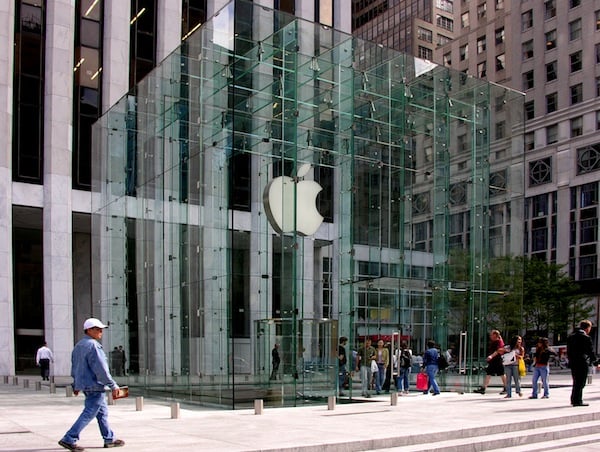
The Apple Store on Fifth Avenue in New York (Source: Wikimedia Commons).
President Obama’s decision to take a five percent pay cut to express solidarity with federal workers affected by the sequester is just one more reminder of the many economic challenges that the United States confronts, some of them a consequence of recent political decisions but others rooted in deeper structural causes. Despite this reality, American innovation in technology and science remains a bright spot; I know that I am not alone in feeling that companies like Apple are largely a source of pride in an otherwise uninspiring political and economic moment.
Not everyone agrees. In a recent New York Times op-ed, journalist and author Eamonn Fingleton, who wrote a book about China’s ascent, argues that Americans should not assume that the U.S. is destined to remain a global innovation leader. Fingleton raises several provocative points that question the thesis that American-style democracy is a necessary condition for success in innovation:
- “Congress might be at loggerheads, the unemployment rate might be too high and America’s infrastructure might be crumbling — but Americans of all political viewpoints comfort themselves with the notion that at least they lead the world in high technology and always will. It’s a pleasing, convenient idea. China can’t outrun the United States, because it’s not creative enough. It’s authoritarian. Democracy is central to innovation, according to this comforting scenario. Although America has accounted for a sizable share of all technological innovations that have shaped our modern world, the wider historical evidence is disappointing for anyone who thinks political freedom is a fundamental precondition for innovation.”
- “Even the evidence of America’s own history undercuts the “all you need is freedom” story. Though from the start freedom was central to the country’s political culture, Americans have not always ranked as technological leaders. America’s technological coming of age was remarkably recent. As Ralph Gomory, former head of I.B.M.’s research department pointed out to me in an interview, America was noted up to the 1930s mainly as an inspired adapter of other nations’ technologies — a role similar to that of Japan and other East Asian nations in more recent times. How do we explain America’s sudden mid-20th-century ascent to technological glory? The credit goes not to freedom but to something more prosaic: money. With World War II, the United States government joined corporations in ramping up spending on R&D, and then came the cold war and the Soviets’ launch of Sputnik in 1957, which gave further impetus to government-funded research. One result was Darpa, which helped develop the Internet.”
In addition to pointing to the historical record, Fingleton argues that the amount of money countries spend on innovation plays an important role in outcomes, noting the resources that China increasingly commits to research and development as well as China’s achievements in patent filing.
On the other side of the coin, the Economist — in a March 2013 article and special report — is much more bullish on the United States’ future place in the global economy. The article starts by laying out many of the same well-acknowledged challenges that the United States confronts, saying, “[America’s] debt is rising, its population is ageing in a budget-threatening way, its schools are mediocre by international standards, its infrastructure rickety, its regulations dense, its tax code byzantine, its immigration system hare-brained — and it has fallen from first position in the World Economic Forum’s competitiveness ratings to seventh in just four years.” However, the Economist also argues that among other positive developments like education reform (though American readers are likely to be divided on how positive these developments are), American technical and scientific innovation is going strong. As the article argues:
Investment in research and development as a share of output recently matched the previous record, 2.9% of GDP, set at the height of the space race. America is home to 27 of the 30 universities that put out the most-cited scientific research—and it is still good at developing those ideas.
Which of these narratives is correct, and is there any way to reconcile them? I believe that Fingleton makes a valuable contribution by placing the United States’ innovative advantage in historical context and providing a sense of China’s research achievements, which in my view are not widely discussed. However, Fingleton, like many others who comment on the rise and the eventual dominance of China, fails to mention the domestic factors that are likely to hamper China’s rise, which range from ongoing environmental catastrophe to civil unrest. This is where China’s lack of democratic institutions may hurt its innovative potential, if in a more roundabout way than those who study innovation usually suggest. The United States, experiencing the gridlock of an advanced democracy, is on the opposite end of this challenge. If China’s growth and development will likely suffer due to friction generated by a democratic deficit, the U.S. economy is currently suffering from the friction of political polarization.
In the coming weeks, I will continue to explore national competitiveness as well as debates about American technology and businesses in China (and vice versa).